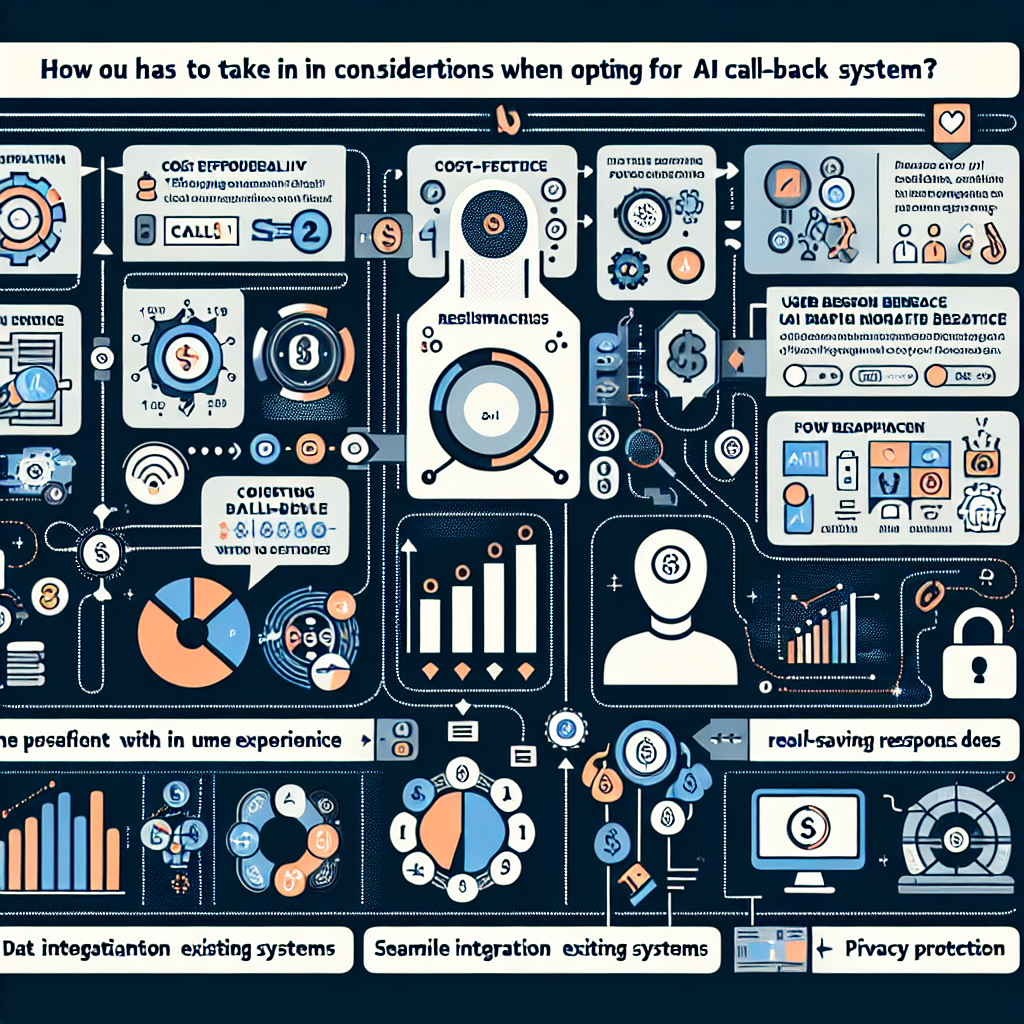
In today's fast-paced world, customer service efficiency is paramount. Dealing with an influx of calls during peak business hours can be challenging for many companies. This is where Automated Call-back Technology comes into play.
Automated Call-back Technology is a sophisticated tool designed to alleviate the pressure on customer service representatives and improve overall business efficiency. This powerful aid reduces not only the average handle time but also the operational costs associated with managing extreme call volumes.

Automated Call-back Technology works by offering callers the option to request a return call, rather than waiting on the line when the system is congested. This is achieved by leveraging robust AI and automation. When a customer agrees to stand by for a call return, the system securely logs their contact number and adds it to a queue.
Once the call volume normalizes, or an agent becomes available, the automated system dials out to the customer. This ensures reduced wait time for customers and allows agents to handle calls more efficiently during peak times.
Moreover, automated call-back technology is not limited to phone systems. Businesses can also utilize this tool in multichannel communication strategies, where customers get the option for a call-back across different platforms such as email, live chat, social media, etc.
Now more than ever, businesses need to adapt to customer service challenges promptly, and adopting Automated Call-back Technology is a step in the right direction. It significantly enhances customer service, ensuring customer satisfaction, and facilitates efficient resource allocation during peak hours. The integration and deployment of this intuitive tool is certainly worth considering for dynamic businesses ready to revolutionize their customer service approach.
In the contemporary era of customer service, automated call-back scheduling has emerged as an essential tool in peak hour management. One might wonder, what makes these AI tools so intriguing? The answer lies in their broad spectrum of benefits, including but not limited to: reduced wait times, enhanced customer satisfaction and optimized resource management.
A major challenge faced by businesses is prolonged customer wait times. This is where AI Call-Back Solutions shine as they provide the opportunity for customers to schedule a call-back, rather than waiting endlessly on the line. This not only reduces the perceived and actual wait times, but also respects the timeless adage "Customer time is valuable".
Following this, when wait times are suitably managed, it predictably leads to increased customer satisfaction. A study, linking customer satisfaction to wait times, found that customers appreciate proactive measures such as automated call-backs that showcase a company's dedication towards providing a seamless customer experience. Thus, these AI tools can significantly improve customer satisfaction.
Moreover, using AI for efficient resource management can truly revolutionize how a call center operates. During peak hours, these clever AI solutions can help distribute calls consistently, manage staff assignments more efficiently, and even predict call volumes using historical data. This not only ensures an optimal use of available resources, but it also helps reduce overall operational costs.
Thus, the myriad benefits of automated call-back solutions are clear as they bring substantial improvements in wait time, customer satisfaction, and resource management. By integrating these AI tools, businesses can truly innovate their customer service experience and bring it to the next level.
As greater emphasis is placed on customer service, the addition of tools like automated AI call-back technology is becoming pivotal in managing peak times without increasing staff workload. Businesses are now realizing significant operational efficiencies by integrating these tools with their standard Customer Relationship Management (CRM) systems and productivity tools.

Seamless Integration is a crucial aspect of this transformation. These advanced algorithms are designed to integrate smoothly with the existing architectural frameworks of popular CRMs and productivity tools. Furthermore, APIs provided by technology providers make this connectivity even easier to implement. The result? A streamlined, data-driven approach for managing customer contacts during peak times.
The second major benefit of these tools is Enhanced Communication Flow. AI call-back systems can glean essential information from your CRM, providing context about customer's history, their needs, previous interactions, and more. They can even set priority levels to queue calls accordingly, ensuring important contacts always have an optimal experience. This ability to gather and utilize data makes these tools incredibly smart when scheduling call-backs at the most opportune moments.
Finally, Data Synchronization plays an integral role in maintaining operational consistency. As AI takes over the function of managing call-back schedules, it leaves an imprint of every action within your CRM. Due for a call-back? The CRM is updated immediately with this information. Just finished a call? The activity log gets real-time updates. This level of synchronization enhances coordination across organizational units, ensuring accurate interactions and eliminating redundancies.
In a world that increasingly values immediate, personal interaction, businesses must find innovative ways to engage with their customers. The integration of AI call-back technology with CRM systems and productivity tools is a major leap toward managing peak times efficiently and effectively.
In today's digital era, businesses are embracing AI technologies to optimize their customer service workflows. Implementing automated call-back scheduling is one such strategy. This technique, which uses AI to manage and schedule call-backs during peak times, has recorded phenomenal real-world success. Various firms have shared inspiring testimonials that underline its potential.
Firstly, we have Inkpact, a customer engagement company that effectively integrated AI call-back scheduling tools.
Their situation was challenging. With peak customer contact times lining up with their busiest internal periods, they struggled to balance client servicing with managing operational duties. They sought a solution that could handle inbound calls and return them during less busy periods. The implementation of an AI call-back scheduling system was a game-changer.
Inkpact observed a marked improvement in their efficiency levels. Now, clients had the option to request a callback at their convenience without having to wait on hold. The automated process resulted in fewer dropped calls and a substantial increase in customer satisfaction levels.
Another winner in this terrain is the multi-channel retailer, Argos. Their peak times often coincided with promotional launches - a double whammy leading to a sudden influx of calls. Argos turned to AI scheduling tools and reaped significant benefits.
Post implementation, Argos experienced a whopping 50% drop in abandoned calls. The company noted that providing customers with a call-back option led to higher engagement rates and bolstered customer loyalty. The ROI from the system was tremendous, with improved revenue figures further justifying their decision.
These success stories spotlight the power of combining AI with call management. The seamless blend of automation and customer service allows businesses to manage call surges during peak times without compromising on quality or efficiency. Automated call-back scheduling is indeed proving to be a formidable tool in the customer service arsenal, bringing significant leaps in performance and satisfaction rates..
When seeking to integrate AI call-back systems to manage peak times at your organization, choosing the right tool is crucial. Various factors such as the scale of your business, the size of your customer base, and your industry-specific needs should influence your choice.

The size of your business plays a significant role in determining the best AI call-back system. For example, small businesses often deal with fewer calls compared to larger corporations. Therefore, a system built with scalability in mind might be overkill for a small enterprise with modest requirements. A tool that offers essential functionalities without being overly complex will often be the best fit.
Understanding the nature and demographics of your customer base is equally important. Some customers might not adapt well to automated systems and prefer to interact with human customer agents. Hence, a hybrid system combining AI and human agents may be optimal for some businesses.
Furthermore, you should review your industry-specific needs. Industries such as health services, banking, and online retail often require robust security for customer interactions. Thus, an AI system providing advanced security measures would be suitable.
Finally, ensure that the system you choose can seamlessly integrate with your existing technology stack. Compatibility with your CRM, VoIP, and any other crucial software used in your operations is a must-have feature. A lack of this harmony could result in inefficient operations and even data loss. You can refer to this guide for further insights.
In conclusion, while the benefits of an AI call-back system are undeniable, choosing one must be done with caution considering the size and type of your business, customer demographics, and industry-specific and software compatibility needs.
Start your free trial for My AI Front Desk today, it takes minutes to setup!








